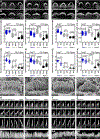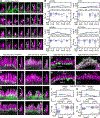Mechanotransduction-Dependent Control of Stereocilia Dimensions and Row Identity in Inner Hair Cells
- PMID: 31902726
- PMCID: PMC7002276
- DOI: 10.1016/j.cub.2019.11.076
Mechanotransduction-Dependent Control of Stereocilia Dimensions and Row Identity in Inner Hair Cells
Abstract
Actin-rich structures, like stereocilia and microvilli, are assembled with precise control of length, diameter, and relative spacing. By quantifying actin-core dimensions of stereocilia from phalloidin-labeled mouse cochleas, we demonstrated that inner hair cell stereocilia developed in specific stages, where a widening phase is sandwiched between two lengthening phases. Moreover, widening of the second-tallest stereocilia rank (row 2) occurred simultaneously with the appearance of mechanotransduction. Correspondingly, Tmc1KO/KO;Tmc2KO/KO or TmieKO/KO hair cells, which lack transduction, have significantly altered stereocilia lengths and diameters, including a narrowed row 2. EPS8 and the short splice isoform of MYO15A, identity markers for mature row 1 (the tallest row), lost their row exclusivity in transduction mutants. GNAI3, another member of the mature row 1 complex, accumulated at mutant row 1 tips at considerably lower levels than in wild-type bundles. Alterations in stereocilia dimensions and in EPS8 distribution seen in transduction mutants were mimicked by block of transduction channels of cochlear explants in culture. In addition, proteins normally concentrated at mature row 2 tips were also distributed differently in transduction mutants; the heterodimeric capping protein subunit CAPZB and its partner TWF2 never concentrated at row 2 tips like they do in wild-type bundles. The altered distribution of marker proteins in transduction mutants was accompanied by increased variability in stereocilia length. Transduction channels thus specify and maintain row identity, control addition of new actin filaments to increase stereocilia diameter, and coordinate stereocilia height within rows.
Keywords: Airyscan; actin; development; hair bundle; hair cells; mechanotransduction; myosin; stereocilia.
Copyright © 2019 Elsevier Ltd. All rights reserved.
Conflict of interest statement
Declaration of Interests The authors declare no competing interests.
Figures







Comment in
-
Cell Biology: Function Guides Form of Auditory Sensory Cells.Curr Biol. 2020 Feb 3;30(3):R128-R130. doi: 10.1016/j.cub.2019.12.039. Curr Biol. 2020. PMID: 32017884
References
-
- Tilney LG, Tilney MS, and DeRosier DJ (1992). Actin filaments, stereocilia, and hair cells: how cells count and measure. Ann. Rev. Cell Biol 8, 257–274. - PubMed
-
- Kaltenbach JA, Falzarano PR, and Simpson TH (1994). Postnatal development of the hamster cochlea. II. Growth and differentiation of stereocilia bundles. J Comp Neurol. 350, 187–198. - PubMed
-
- Denman-Johnson K, and Forge A (1999). Establishment of hair bundle polarity and orientation in the developing vestibular system of the mouse. J Neurocytol. 28, 821–835. - PubMed
Publication types
MeSH terms
Associated data
Grants and funding
LinkOut - more resources
Full Text Sources
Molecular Biology Databases
Research Materials
Miscellaneous

